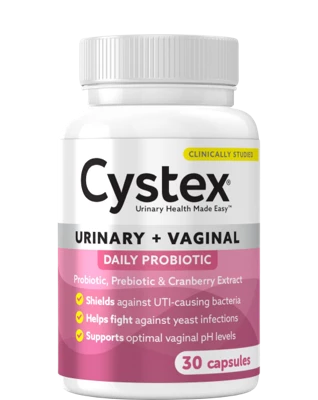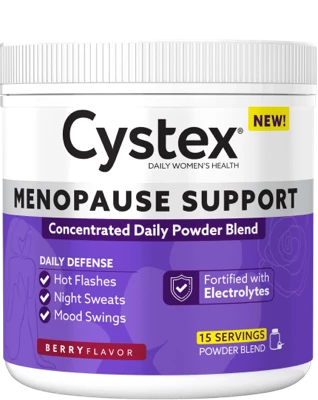-
Products
UTI Relief
Urinary & Vaginal Wellness
Menopausal Health
- UTI Resources
- Helpful Links
- Why Cystex
- Buy Now
What Color is Your Urine? And What Does It Mean?
Next bathroom break, take a peek in the toilet. What color do you see?
Believe it or not, pee isn’t always “yellow.” There’s actually a range of colors that can show up in your urine — some are variations of “normal” and some are signs that it’s time to talk to your doctor.
So, what’s your urine trying to tell you and what should you do about it?
Clear
Wow, you might be really, really hydrated. Unfortunately, it is possible to drink too much water and over-hydration can be a problem. When you take in excessive water, essential electrolyte levels in your blood can drop to dangerous, even fatal, levels. Pregnancy, medications (including diuretics) and medical conditions (like diabetes and kidney or liver issues) can also be linked to clear urine. If you’ve been over-drinking water, cut back and see if your urine returns to normal. If your urine remains consistently clear, check in with your doctor.
Shades of yellow from pale straw to transparent yellow
If it’s yellow, you can feel mellow. See-through yellow is considered the “normal” urine color, from pale straw to deeper, transparent shades. The intensity of your yellow will vary depending on how much water and other hydrating fluids you are (or are not) drinking. The more you hydrate, the more diluted the pigments in your urine will become, resulting in a lighter color. But don’t overdo it (see “clear” above).
Amber or honey
It might be time to hit the H20; amber, dark or honey-colored urine can be a sign of severe dehydration. Try drinking more healthy liquids and keep the weather and your level of activity in mind. If it’s hot and/or you are engaged in strenuous activity, you’ll obviously need more fluids. If urine continues to be dark, talk to your doctor as dark urine can also be a sign of medical concerns needing attention.
Light orange
Light orange urine could be a sign of dehydration (see above) but may also be caused by liver or bile duct problems, food dyes, or excess B vitamins from supplements. You can try improving your hydration and cutting back on vitamins (unless they are prescribed by your doctor) to see if there’s any improvement. But if orange issues are ongoing, give your doctor a call.
Orange
Some medications, such as rifampin or phenazopyridine, can cause orange urine. Make a list of all the medications you’re taking (prescription and over the counter, including supplements) and discuss your what’s going on with your doctor.
Dark orange, “brown ale” or “syrup”
There are a number of possible reasons for dark orange or brown urine. It could be a symptom of a liver condition, jaundice, rhabdomyolysis, Gilbert syndrome, or severe dehydration. Get in touch with your healthcare provider to discuss what may be causing this symptom and how to proceed.
Fluorescent yellow/orange
Things are looking interesting, huh? What have you been eating and drinking lately? Things that are high in vitamin C, like beets, carrots and carrot juice can cause vivid hues in your urine. So can some vitamin supplements and medications, including urinary tract infection treatments. Your hydration status could also be a factor so be sure you’re drinking enough fluids. If your bright colors continue, reach out to your doctor to talk about the situation. Bright yellow or orange urine can sometimes be an early sign of a liver issue — something that would need professional diagnosis and treatment.
Pink
Ok, don’t freak out. Certain foods like carrots, blackberries, blueberries, beets, and rhubarb can turn urine a pinkish-red color. It’s also possible that you have blood in your urine – which could be a sign of aurinary tract infection (UTI), kidney problem, prostate problem (in men), or a tumor. Some medications can cause pink or red urine, too. As we said, don’t freak, but do talk to your doctor if you don’t think food is the cause or if your pink or red urination continues.
Red, blood-tinged, or rust-colored
As discussed above, pink or red urine can be due to blood in the urine, also called hematuria. This can be caused by a number of things, some are not a big deal, sometimes we don’t know what’s causing the problem, and sometimes the situation calls for medical attention. Think about the foods you’ve been eating (see “pink,” above). If food doesn’t seem a likely cause, a doctor will consider kidney stones, infections (especially urinary tract infections), tumors, lead or mercury poisoning, or male prostate problems. Long-distance running can sometimes cause blood in the urine, too, and there’s also a rare inherited disorder called porphyria that should be ruled out. Short answer: give your doctor a call about red urine. You’ll be glad you did.
Brown, dark brown or black
Brown or black urine can signal something serious like a liver or kidney problem. Extreme exercise, or eating large amounts of fava beans, rhubarb or aloe may also cause brown or cola-colored urine. Some medicines can darken urine, too. More concerning is that this discoloration could be caused by copper or phenol poisoning or melanoma. So, these are colors that you’ll definitely want to talk to your doctor about.
Green or blue
Seeing green or blue in the toilet is probably pretty shocking. First thought – do you have a kid in the house playing jokes on you? No? Then consider if you’re eating artificial coloring in foods or medicines, binging on asparagus, or taking excess B vitamins. Each could cause urine to turn green or blue. A bacterial infection in the urinary tract could also cause green/blue urine. A few rare medical conditions are possibilities, too. Let your doctor know if the color doesn’t go away after a short time.
Purple
Good news and no need to blame mom’s eggplant parmesan! There’s no such thing as purple urine!
White, foamy or milky
Cloudy, murky, foamy, or milky urine can have a few causes. There may be too many of certain minerals (such as calcium or phosphate) in your system, or you may have a UTI or excessive proteins in your urine. Other causes could be bacterial vaginosis, a yeast infection, kidney stones, or some other urinary tract or kidney condition. Do you have painful urination, reduced urine flow or increased feelings of the urge to urinate? There are all things your doctor should be made aware of.
There’s so much more to urine than many of us ever think about! Thankfully, most of the time, we’re peeing yellow and feeling good about it. If things start to get more colorful than that, please don’t hesitate to get insights and appropriate care from a trained medical professional.
Wondering if you have a UTI? Check out the usual symptoms, here and remember that the only effective treatment is a prescription antibiotic. But, while you wait, you can help slow the progression of the infection by using the over-the-counter urinary pain reliever Cystex. Bonus: Cystex will not change the color of your urine as some other UTI treatments may.










